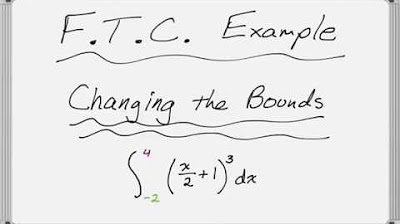Definite Integral With U-Substitution
TLDRThe video script offers a detailed walkthrough of solving a definite integral involving a square root of a linear expression. The presenter introduces the concept of u-substitution as a method to simplify the integral of x over the square root of (36 + 3x) with respect to dx. The process involves setting u equal to 36 + 3x, finding du/dx, and then transforming the integral into a more manageable form involving u. The integral is split into two separate integrals, which are then solved using basic integration techniques. The constants are factored out, and the integration is performed, resulting in expressions involving powers of u. The solution is then simplified, and the plus c (constant of integration) is included. The boundaries for the definite integral are determined by substituting the limits of x (0 and 15) back into the original u expression. Finally, the definite integral is evaluated at the determined boundaries, providing the final result. The video encourages continuous learning and leaves the audience with a clear understanding of how to approach and solve complex integrals using u-substitution.
Takeaways
- 📚 Start with a clear understanding of the definite integral problem, especially when dealing with square roots of linear expressions.
- 🔁 Use substitution (u-substitution) to simplify the integral, particularly when the integrand is complex.
- 📐 Identify the substitution variable (u) and express the integrand in terms of u to simplify the integration process.
- 🧮 Find the relationship between dx and du, which is crucial for the substitution method.
- 📉 Rewrite the integral in terms of u and simplify the expression before proceeding with integration.
- 📈 Split the integral into separate parts that can be integrated more easily.
- 🔢 Apply the power rule for integration, adjusting for the constants and exponents involved.
- 🔄 Remember to include the constant of integration (C) in your solution before applying the limits of integration.
- 🏁 Apply the limits of integration to the integral in terms of u, not x, since the integration was performed with respect to u.
- ✅ Evaluate the integral at the specified boundaries (in this case, 0 and 15) to find the definite integral's value.
- 🧮 Perform the final simplification of the integral result to get a numerical answer, ensuring all steps are correctly executed.
Q & A
What is the main topic of the video?
-The main topic of the video is the evaluation of a definite integral involving a square root of a linear expression.
Why is a substitution method used in this context?
-A substitution method is used to simplify the integral by replacing a complex expression with a simpler variable, making the integration process easier.
What is the substitution variable 'u' set to in this video?
-The substitution variable 'u' is set to 36 plus 3x.
How is 'x' expressed in terms of 'u' after the substitution?
-After the substitution, 'x' is expressed as (u - 36) / 3.
What is the expression for 'du/dx' in terms of 'u' and 'x'?
-The expression for 'du/dx' is 3, since after the substitution, 'dx' is replaced by 'du/3'.
How does the integral transform after the substitution?
-The integral transforms to the integral of (u - 36) / (9 * sqrt(u)) du, after simplifying the expression and accounting for the substitution.
What is the strategy for simplifying the integral after the substitution?
-The strategy is to split the integral into two separate integrals, which can then be integrated more easily due to their simplified forms.
How is the integral of u over the square root of u simplified?
-The integral of u over the square root of u is simplified by recognizing that u / sqrt(u) is the same as u^(1/2), and then the integral is written as (1/9) * u^(1/2) du.
What is the purpose of including the constant 'C' after integration?
-The constant 'C' is included to represent the constant of integration, which is necessary when the integral does not have specified boundaries or the integration is indefinite.
How are the boundaries of the definite integral determined?
-The boundaries of the definite integral are determined by the values of 'u' corresponding to the limits of 'x', which in this case are when x is 0 and when x is 15.
What is the final step in evaluating the definite integral?
-The final step is to substitute the boundaries into the integrated expression and perform the evaluation to find the definite integral's value between the given limits.
What is the final result of the definite integral between the boundaries of 0 and 15?
-The final result of the definite integral between the boundaries of 0 and 15 is 14.
Outlines
📚 Introduction to Definite Integrals with Substitution
The video begins with an introduction to definite integrals, specifically focusing on an integral involving a square root of a linear expression. The presenter suggests using a substitution method to simplify the integral. They propose to rewrite the integral to avoid repetitive writing of constants and introduce a substitution with u = 36 + 3x. The presenter then calculates du/dx and shows that dx = du/3. The integral is transformed and split into two separate integrals, which are then simplified using the properties of exponents and roots.
🧮 Integration and Constant Separation
After preparing the integral for substitution, the presenter moves on to the integration process. They move constants outside of the integral and proceed to integrate the simplified expressions. The integration results in expressions involving u to the power of 3/2 and 1/2. The constant of integration, C, is included as a reminder that boundaries have not yet been applied. The presenter then substitutes back to the original variable x, calculating the values of u at the boundaries x = 0 and x = 15, which are 36 and 81, respectively.
🔢 Evaluation of Definite Integral with Boundaries
With the integral in terms of u now integrated, the presenter applies the upper and lower boundaries to evaluate the definite integral. They calculate the integral at the upper boundary (u = 81) and subtract the integral at the lower boundary (u = 36). The presenter simplifies the resulting expression step by step, applying arithmetic operations and recognizing common factors to reduce the complexity of the expression. The final simplified result of the definite integral from 0 to 15 of the given expression is obtained and the video concludes with an encouragement to continue learning.
Mindmap
Keywords
💡Definite Integral
💡U-Substitution
💡Square Root
💡Linear Expression
💡Differentiation
💡Integration
💡Constants
💡Product Rule
💡Boundary
💡Plus C
💡Evaluation
Highlights
Introduction to the concept of definite integrals and the need for evaluation post-integration when dealing with square root signs.
Suggestion to use a u-substitution to simplify the integral involving a square root of a linear expression.
Rewriting the integral expression to avoid repetitive writing and to focus on the integral of x over the square root of (36 + 3x).
Setting up the u-substitution with u = 36 + 3x and solving for x in terms of u.
Calculating du/dx and expressing dx in terms of du, which simplifies the integral.
Transforming the integral into a new form based on the substitution, making it easier to integrate.
Rearranging the integral to separate it into two simpler integrals that can be solved more easily.
Applying the product rule to simplify the expression u/√u as u^(1/2).
Integrating the separated expressions and applying constant factors outside of the integral.
Adding the constant of integration (C) to account for the indefinite nature of the integral before applying boundaries.
Substituting the boundaries in terms of u to evaluate the definite integral.
Calculating the upper and lower boundaries when x equals 15 and 0, respectively, to apply them to the integral.
Evaluating the integral at the determined boundaries to find the definite integral's value.
Simplifying the final expression by combining like terms and reducing fractions.
Final evaluation of the integral resulting in a simplified numerical answer.
Emphasizing the importance of continuous learning and the connection between learning and living.
Transcripts
Browse More Related Video

Fundamental Theorem of Calculus: Changing the Bounds with u-Substitution

Another u-subsitution example

Definite Integrals from Graphs (Part 2 of 3) - U-Substitution

_-substitution: definite integrals | AP Calculus AB | Khan Academy

Back Substitution - When a u-sub doesn't match cleanly!

_-substitution: defining _ | AP Calculus AB | Khan Academy
5.0 / 5 (0 votes)
Thanks for rating: